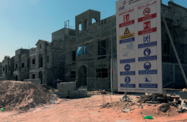Saudi Arabia’s construction industry has been forecast to be one of the Kingdom’s best performing sectors in 2012, with an increasing flow of state contracts coming its way. However, bottlenecks in the materials supply chain and high demand for labour and resources could push up prices.
In early January international ratings agency Fitch issued a report predicting the construction sector in the Middle East and North Africa (MENA) region would be underpinned by massive investments from Riyadh. While many other countries in the region are scaling back their construction spending, Saudi Arabia – along with Qatar – are in the process of stepping up outlays for building work, the report said.
The construction industry is already one of Saudi Arabia’s high-performance sectors, having expanded by 11.6% in 2011 – second only to manufacturing and well up on the overall 6.8% increase in GDP – according to a report issued by Riyadh-based Jadwa Investment at the end of December.
Fuelled by higher state spending, this strong growth is likely to carry over into 2012, the Jadwa report said, with construction and utilities expected to be the fastest growing sectors and the economy forecast to expand by between 2.7% and 3%.
The details of this increased state investment in construction projects was set out in the 2012 budget. Unveiled at the end of December, the budget foresees a 19% increase in expenditures, with much of this additional spending going towards educational, social and health facilities and infrastructure projects, all of which mean more work for the already busy sector.
At the same time, a separate fund of $66.7bn, taken from the 2011 budget surplus, was set aside for the construction of 500,000 new housing units. This was allocated to the Saudi Arabian Monetary Agency, which has been tasked with overseeing the programme, according to local media reports.
Not surprisingly, the steep increase in spending on construction projects set out in the budget helped to drive up the share prices of many of Saudi Arabia’s leading building and materials firms. The day the budget was announced, for example, shares in Arabian Pipes climbed 9.7%, while competitor Saudi Steel Pipes saw its value jump by 8.3%.
Other materials providers did almost as well, with Yamamah Saudi Cement gaining 2.8% and Yanbu Cement up 4.3%, while shares in the National Company for Glass Industries rose by 4.6% on the day and building firm Al Khordari advanced by 5%.
This contrasted with construction firms in other parts of the region, which saw 2011 close in something of a lacklustre manner due to lower expectations for the coming year. The slowdown in regional construction activity could be a blessing for Saudi Arabia, however, as easing demand for materials could mean lower costs or at least a decrease in inflationary pressure.
In its report Fitch also identified another potential avenue for savings, suggesting that with fewer tenders being called there would be more competition for those projects that were announced. This in turn would lead builders to undercut each other when bidding.
“In Saudi Arabia and Qatar, infrastructure spending continues to be strong but with lower margins,” said Bashar Al Natoor, the director of the rating agency’s Europe, Middle East and Africa corporate teams in Dubai. “During the construction boom, MENA region contractor margins have remained higher than international peers. However, with the recently increasing competition, contractors have started to go for lower margins, and Fitch expects this to remain the case over the next few years.”
Though more construction capacity is becoming available in the region, the sheer scope of Saudi Arabia’s project list may negate the opportunities for reducing margins, especially if the government pushes to keep completion dates on track.
One factor that could hold back the construction sector this year are supply constraints, with the possibility that a shortage of some materials, particularly cement, could slow down the speed at which projects are rolled out.
In late December, investment firm NCB Capital warned that problems related to providing increased stock of subsidised fuel to two cement firms could lead to delays in the addition of 4.5m tonnes of much-needed production capacity.
“The potential demand-supply imbalance could become particularly acute in the Western region, where demand is expected to be high,” the NBC Capital report said.
Though Saudi Arabia’s construction industry will be under pressure to continue to step up its already impressive game this year, its track record suggests it will be able to rise to the occasion. With 2012 marking the beginning of a long-term cycle of investment and development, the sector looks set to build up some impressive momentum.

